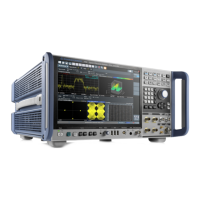Common Analysis and Display Functions
R&S
®
FSW
539User Manual 1173.9411.02 ─ 43
If activated, the delta markers display the phase noise measured at defined offsets
from the reference position.
Remote command:
CALCulate<n>:DELTamarker<m>:FUNCtion:PNOise[:STATe] on page 1187
CALCulate<n>:DELTamarker<m>:FUNCtion:PNOise:RESult? on page 1186
Defining Reference Point
Instead of using marker 1 as the reference marker, a fixed reference marker can be
defined for phase noise measurement.
The "Level" and "Frequency" or "Time" settings define the position and value of the ref-
erence point.
Alternatively, a Peak Search can be performed to set the maximum value of the
selected trace as the reference point.
If "Automatic Peak Search" is activated, a peak search is started automatically after
each sweep and the result is used as the reference point.
Remote command:
CALCulate<n>:DELTamarker<m>:FUNCtion:FIXed:RPOint:Y on page 1180
CALCulate<n>:DELTamarker<m>:FUNCtion:FIXed:RPOint:X on page 1179
CALCulate<n>:DELTamarker<m>:FUNCtion:FIXed:RPOint:MAXimum[:PEAK]
on page 1179
CALCulate<n>:DELTamarker<m>:FUNCtion:PNOise:AUTO on page 1186
Switching All Phase Noise Measurements Off
Deactivates phase noise measurement for all markers.
Remote command:
CALCulate<n>:DELTamarker<m>:FUNCtion:PNOise[:STATe] on page 1187
9.3.4.4 Measuring Characteristic Bandwidths (n dB Down Marker)
Access: "Overview" > "Analysis" > "Marker Functions" > "n dB down" > "n dB Down
Config"
Or: [MKR FUNC] > "Select Marker Function" > "n dB down" > "n dB Down Config"
When characterizing the shape of a signal, the bandwidth at a specified offset from its
peak level is often of interest. The offset is specified as a relative decrease in ampli-
tude of n dB. To measure this bandwidth, you could use several markers and delta
markers and determine the bandwidth manually. However, using the n dB down marker
function makes the task very simple and quick.
The n dB down marker function uses the current value of marker 1 as the reference
point. It activates two temporary markers T1 and T2 located on the signal, whose level
is n dB below the level of the reference point. Marker T1 is placed to the left and
marker T2 to the right of the reference marker. The default setting for n is 3 dB, but it
can be changed.
If a positive offset is entered, the markers T1 and T2 are placed below the active refer-
ence point. If a negative value is entered (for example for notch filter measurements),
the markers T1 and T2 are placed above the active reference point.
Marker Usage

